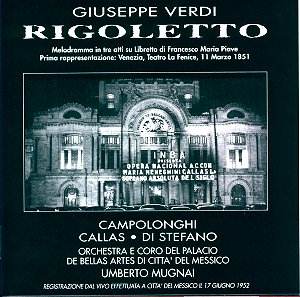In June 1952, Maria Callas gave a legendary series
of performances at the Palacio de las Bellas Artes, Mexico City. That
series included not only this "Rigoletto", but three performances of
"Lucia di Lamermoor" at the first of which she reprised the entire Mad
scene. Callas went on to record "Rigoletto" in 1995 at La Scala in a
studio recording with Tito Gobbi in the title role. Inevitably this
recording can never replace that one and Pietro Campolonghi is no match
for Tito Gobbi, but it is a fascinating and rewarding document.
Callas's 'Gilda' is no naïve simpleton and she
opens with a very strongly sung performance, youthful but never completely
girlish. Only after her seduction, does she allow her interpretation
to broaden, suggestive of all that has happened and her development
into a young woman. At this stage of her stage career, Callas had developed
artistically but her voice needs few of the apologies that are needed
later on in her career. So here, through the not inconsiderable haze
of the recording, we can glimpse Callas the mature artist. As for her
leading man, for all his faults, Giuseppi di Stefano's open throated,
seductive 'Duca di Mantova' is in a class rarely achieved today and
his performance is always a pleasure to listen to.
Pietro Campolonghi is not a great 'Rigoletto', but
he was part of a still vital performing tradition. A tradition which
has all but vanished today. And as such, his performance has much of
interest, though it tends to be rather generalised and not a little
hammy - good enough on its own but rather put into the shade when Callas
is on the stage. His opening lacks the bite of his rival Tito Gobbi
or a later singer like Piero Cappuccilli.
The singers playing Sparafucile and Maddalena are no
more than adequate, some times not even that. Their inadequacies considerably
weaken the Terzetto and Tempest in Act 3, with Gilda overhearing their
plotting. This scene, also, has problems with the recorded balance,
Callas is obviously considerably further from the microphone than the
other two, and the general ensemble between stage and pit is poor.
This is a very traditional performance which, in our
current climate of 'come scritto' performances, is welcome. But the
principals give very committed performances, though traditional, very
little is just routine. There is plenty of audience applause interrupting
the action and the men, in particular, are fond of over-extended high
notes. Di Stefano repeats the second verse of 'La donna e mobile'.
A recording of this performance has appeared before,
notably on Melodram but this CD claims that this recording is from a
new source and it has been treated with the USD24 sound restoration
system. People's response to these sound restoration systems is notoriously
variable. Generally I prefer as little interference as possible, I find
my ear becomes accustomed to the sound and filters out what is unnecessary.
Additionally, most sound cleaning system cause you to lose something
though it is not to everyone's taste to try discern the details of a
fine performance of "Rigoletto" from amidst a hailstorm of
noise. That said, the sound quality on this set is just about adequate
and one's ear quickly becomes used to it, though the louder ensembles
can sound congested. The recording is apt to make Callas's upper-most
register sound a little steely, but research would be needed to check
whether this was caused by the sound restoration, the original recording
process or was just naturally Callas in 1952.
The set has other, greater disadvantages. The ensemble
is frequently poor (and sometime quite atrocious), the conductor (Umberto
Mugnai) is unable to keep his orchestra, chorus and singers together.
The opening scene, with its off-stage band, at times becomes positively
confused. And the singers are prompted in such a repeated and audible
manner, that it starts to become part of the performance - turning Callas
and di Stefano's Act 1 duet into a trio. And did Callas really require
so much prompting in 'Caro Nome'?
On the plus side, balance between pit and stage is
just about acceptable, though soloists are apt to wander in and out
of focus. And Callas is in coruscating form. Apart from the 1955 studio
recording, recordings of these Mexico performances of "Rigoletto" seem
to be the only other record of Callas as 'Gilda'. This will never be
a first choice recording for "Rigoletto". Nor can it be first choice
for "Rigoletto" with Callas as 'Gilda', that goes to the 1955 EMI recording.
What this is, though, is a valuable record of Callas performing the
role live. With such a volatile artist as Callas, every live performance
was an event and we are to be grateful that we have this opportunity
to eavesdrop, even if only dimly.
Robert Hugill

